Instead of a quote, a quiz… The Shadow, a.k.a. The Dark Eagle or The Black Eagle, was originally a figment of the pulp fiction genre, later the radio, and still later, television and cinema. His motives and methods were always a touch suspect, and, particularly in the early years of pulp and radio, he was a thief, who also used his skills to fight other crimes – sort of a precursor to John Roble of To Catch a Thief or Alexander Mundy, of It Takes a Thief, infamy, though without the police coercion. When not in his dark crime fighting mode, he was really:
a. Kent Allard, aviator
b. Lamont Cranston, playboy
c. Henry Arnaud, businessman
d. Isaac Twambley, elderly gentleman
e. Fritz, janitorThe answer will be at the bottom of this post, for the moment, “Only the Shadow knows…”
Being the 80th anniversary of the first radio broadcast of The Shadow, this past weekend was not a celebration of his origins, but of a change in format and character, more about which down below. There was, not surprisingly, little of food-related information that would help to construct a dinner menu. A few cocktails, mostly sounding completely unappealing bear the moniker “shadow”, generally accompanied by a color designation. But there was enough to both come up with some inspirations, and, to simply make other things up in the shadowy recesses of my mind….
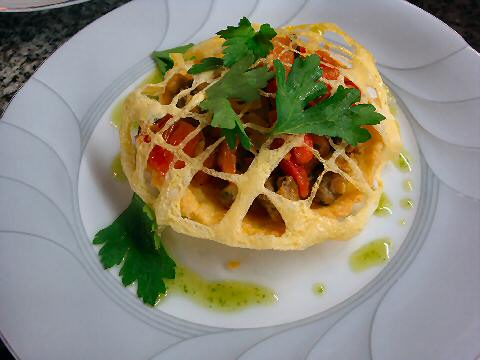
World of Warcraft, the online game, had a recipe that involved a “Mote of Shadow” and “Succulent Clams” – if you don’t play MMORPGs, (and have no idea what that acronym means), that probably doesn’t register in your reality, but suffice it to say it was sufficient to decide on a clam, or actually cockle, dish – and I thought I’d bring back my little cockle tartlets that were a hit last year. First evening, a problem… the tart dough simply didn’t bake right. I can only assume that I mis-measured the weight of either butter or flour in the crust, and having decided to bake them to order, found that although they cooked through, they weren’t firm enough to remove from the tartlet molds. So, with no time to redo them, we served them in the mold, draping the eggnet over the whole thing and drizzling the parsley-chili oil atop – not classy, but not a complete failure. Second night, planning to pre-bake them and cook the filling separately and just combine them for presentation, got a positive shift with a completely different dough when it happened that Yotam Ottolenghi, writer of The Guardian UK‘s new vegetarian column, published a recipe for a cheesy polenta crust that sounded spectacular. It was, and I’m going to use it for this dish, and others, in the future! The dish was prettier last year though – I’ll play with that a bit.
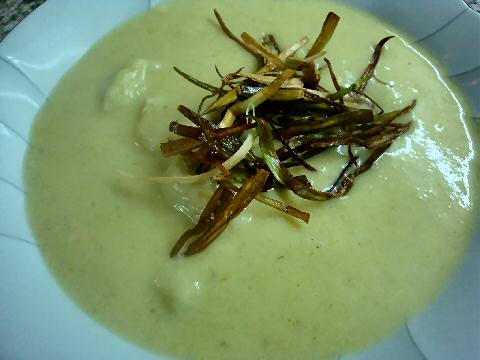
One of the cocktail recipes that didn’t sound completely appalling was the White Shadow, a blend of Pernod, Whiskey, and Cream. I’m not sure I’d want to drink it, but it did sound like it would make a nice soup. So I went back for the fennel soup that I’ve made more than once, with a couple of twists. I finished it with a splash of whiskey and some cream, and in place of the falafel that I’ve used, I went with dumplings – fennel frond dumplings. That more or less came about because the parsley dumplings, or spaetzle, that I served in a recent dinner were such a hit that half the diners over the weekend wrote me to ask for the recipe – 2½ cups flour, 1 tsp salt, 3 eggs, ¾ cup milk, pepper, nutmeg, and 3 tablespoons of finely chopped fennel fronds (or whatever herb you want to flavor them with).
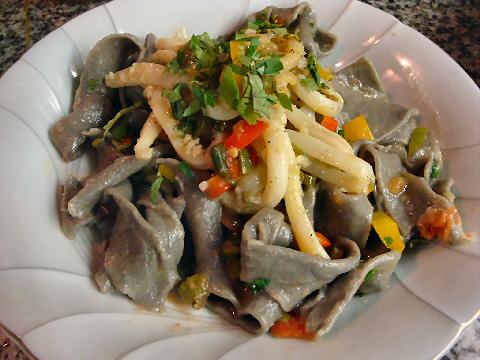
How could we not have a bit of squid ink pasta, the dark color (could have added another pouch of ink to make them even darker, but then they start to taste bitter) tangled together into an interwoven shadow. Of sorts. Homemade pappardelle with squid ink. A medley of peppers for color – red, green, yellow bell peppers, hot chilies, a little green onion, garlic and tomato – all sauteed together and then tossed with the pasta. Separately, finely slivered squid rings marinated in lime juice and zest, garlic and cilantro. Placed atop and then a little more vegetable mixture spooned over it all.
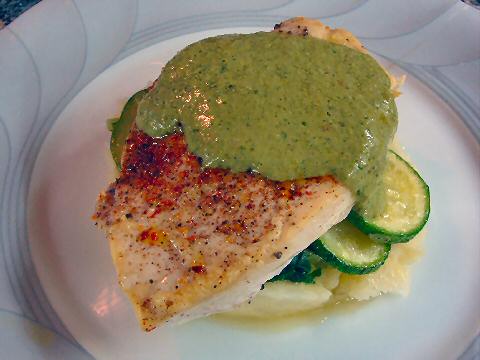
Shado Beni, sometimes written Shadow Benny, is an herb native to the West Indies with a flavor similar to, though not the same, as cilantro. When the herb isn’t available, the latter is used as a more readily obtainable substitute. And it lends its name to a traditional spicy sauce of the area that is basically a puree of the herb with chilies. I just sort of took the idea and ran with it. Here, in layers, mashed yucca root (plenty of butter and cream, salt and white pepper), slow cooked turnip greens with a little garlic, sauteed zucchini, and then chicken that was dry-rubbed with salt, pepper, smoked paprika and chili flakes. The sauce, a just warmed blend of yogurt, curry powder, garlic, cilantro, chipotle in adobo, lime zest and juice, salt. Delicious! Ah, but the embarrassment… not of the dish itself, but, the first night, I had one person who was pescetarian… and I’d planned for it, having dry-rubbed a lovely fillet of trout and planning to do the same thing with it, and, I simply forgot it in the refrigerator, marinating away. And didn’t realize it until I went to pull something out a little later. She didn’t say anything, but I issued apologies – dietary stuff is one of those things I try to be extra careful about – she declined the fish at that point, laying claim to being already stuffed to the gills but I still felt bad.
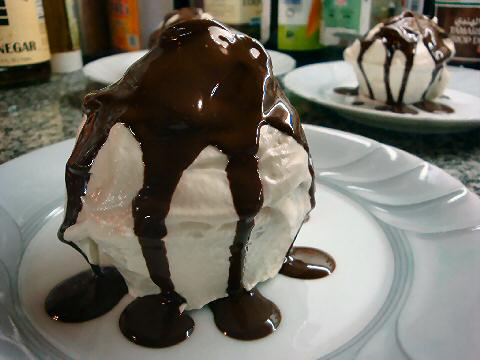
The one recipe that truly stood out as a “Shadow” in and of itself, was Chocolate Shadow Cake, a classic of the norteamericano repertoire. I used the chocolate and chili cake that I’ve had such success with in the past, making cupcakes, and then went with the traditional “fluffy white frosting” and chocolate glaze to, more or less, get the drippy shadow effect.
So, the answer to the quiz. If you picked c, d, or e, you’re wrong. These were identities that at one point or another The Shadow assumed in order to move about town unnoticed, or gain access to information that he might not have otherwise had. If you answered a or b, you’re right, but it depends on which genre. In the pulp fiction, he was Kent Allard, an aviator who had fought with the French air force during WWI, recently returned. Lamont Cranston was an assumed identity – a local playboy indeed, but one whom he blackmailed into swapping places with him when he needed to move in higher social circles and/or gain access to wealthy homes that were in need of burgling. In the radio show, and later in television and cinema, he was simply the playboy and the Kent Allard origins disappeared from the storyline – presumably there was something attractive about the idea of a wealthy gadabout living a life of crime and crime fighting under the very noses of his companions.
hello dessert looks great! i like the the fluffy white frosting, in the recipe i see light corn syrup… what is this called in spanish or how do you subsitute it? gracias
There really is no substitute that works the same way. Here in Argentina it’s usually just called by the brand name of the only one that seems to be available – Kero.
Sugar & Spice Frank passed me a great tip for substituting light corn syrup for candy making with glucose. I can’t find the liquid variety but most pharmacies or health food stores carry boxes of glucose powder. After digging around, I found a site that said to take 1 part glucose powder and .75 parts water and boil the mixture for 3 minutes for glucose syrup. It seems a little bit thin compared to light corn syrup but it works well for most candy making since you have to boil the water out anyway to reach requisite temps. I’m still trying to find a proper glucose/water ratio for the equivalent to light corn syrup for non-candy making recipes but have had no luck. Maybe you don’t need to add water at all and simply measure out the powder in the same quantity as corn syrup?
It does work for candy making, but that’s a completely different “animal” so to speak. Liquid glucose is available here and it does work for making some kinds of frosting, but in the vein of what’s called pastillage, that sort of firm, smooth coating that is wrapped around a cake to make a smooth surface to decorate. It sets too hard to do the “fluffy” sort of frosting. Likely there’s some sort of workaround, but sometimes, substitutes just don’t pull it off and only the real thing will work.